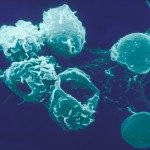Link to Pubmed [PMID] – 11145660
J. Immunol. 2001 Jan;166(2):855-60
The quasi-monoclonal (QM) mouse has a functionally rearranged H chain gene inserted into its natural position in the IgH locus. In this position, the H chain gene is subject to many of the same activities as normally arranged H chain genes, including somatic hypermutation, V(H) gene replacement, and class switch recombination. Here, we have used this mouse strain to determine some of the rules that govern the V(D)J recombination activity of the IgH locus in thymus. We focused on the requirements for V(H) gene replacement. In normal mice, thymic DJ(H) rearrangements are common, but VDJ(H) rearrangements are not. We found intermediate products of V(H) replacement in double-positive CD4(+)CD8(+) cells of the QM thymus, demonstrating that the inserted V(H) gene was accessible and ruling out the possibility that a V(H) gene per se cannot be rearranged in the thymus. We found transcripts from the knocked-in H chain gene of QM, but no mu H chain protein was detectable in thymocytes. Cloning and sequencing of these transcripts revealed that some had been generated by V(H) gene replacement. Corresponding signal joints could also be identified. These results suggest that neither a B cell-specific signal nor an Ig protein are necessary to activate V(H)-to-VDJ(H) joining in thymocytes. Possible mechanisms remaining to account for overcoming the barrier to V(H) joining in thymocytes include the insertion of a transcriptionally active gene segment and/or the inactivation of a silencer.

